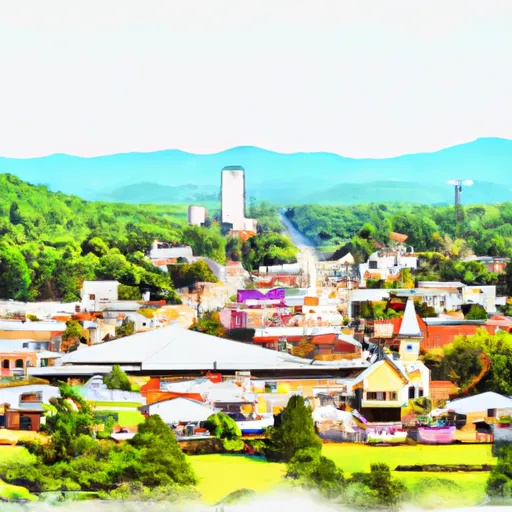-
 Snoflo Premium
Snoflo Premium
Get unlimited access to all our content
With no Ad interruptions! - Start Your Free Trial Login with existing account
Sautee-Nacoochee
Eden Index
Climate
8.4
•
Recreation
7.2
•
Community
0.8
•
Safeguard
6.1/10

Sautee-Nacoochee is a small community located in White County, Georgia, in the northeastern part of the state. The area experiences a humid subtropical climate, characterized by hot, humid summers and mild winters. Summers are typically hot, with temperatures averaging in the high 80s to low 90s Fahrenheit, while winters are mild with temperatures averaging in the 40s to 50s.
The community is surrounded by picturesque natural landscapes, including the Chattahoochee River and various streams, contributing to its hydrology. The Chattahoochee River, known for its recreational activities, runs nearby, providing opportunities for fishing, kayaking, and canoeing. The area's streams also offer fishing opportunities.
Sautee-Nacoochee is renowned for its outdoor recreational opportunities. The region boasts numerous hiking trails, including the popular Raven Cliffs Trail, offering stunning views of waterfalls and the Chattahoochee National Forest. Additionally, the nearby Sautee-Nacoochee Valley provides opportunities for birdwatching, horseback riding, and exploring cultural attractions such as the Sautee-Nacoochee Indian Mound.
In summary, Sautee-Nacoochee, Georgia, offers a pleasant humid subtropical climate, with hot summers and mild winters. The community is surrounded by water bodies, enhancing its hydrology, and provides various outdoor activities such as hiking, fishing, and exploring the natural beauty of the Chattahoochee National Forest and Sautee-Nacoochee Valley.
What is the Eden Index?
The Snoflo Eden Index serves as a comprehensive rating system for regions, evaluating their desirability through a holistic assessment of climate health, outdoor recreation opportunities, and natural disaster risk, acknowledging the profound impact of these factors on livability and well-being.
Climate Health Indicator (CHI): 8.4
Sautee-Nacoochee receives approximately
1700mm of rain per year,
with humidity levels near 76%
and air temperatures averaging around
15°C.
Sautee-Nacoochee has a plant hardyness factor of
7, meaning
plants and agriculture in this region tend to thrive during the non-winter months.
By considering the ideal temperature range, reliable water supplies, clean air, and stable seasonal rain or snowpacks, the Climate Health Indicator (CHI) underscores the significance of a healthy climate as the foundation for quality living.
A healthy climate is paramount for ensuring a high quality of life and livability in a region, fostering both physical well-being and environmental harmony. This can be characterized by ideal temperatures, reliable access to water supplies, clean air, and consistent seasonal rain or snowpacks.
Weather Forecast
Streamflow Conditions
Apalachicola
Area Rivers
Apalachicola
Snowpack Depths
Apalachicola
Reservoir Storage Capacity
Apalachicola
Groundwater Levels
Recreational Opportunity Index (ROI): 7.2
The Recreational Opportunity Index (ROI) recognizes the value of outdoor recreational options, such as parks, hiking trails, camping sites, and fishing spots, while acknowledging that climate plays a pivotal role in ensuring the comfort and consistency of these experiences.
Access to outdoor recreational opportunities, encompassing activities such as parks, hiking, camping, and fishing, is crucial for overall well-being, and the climate plays a pivotal role in enabling and enhancing these experiences, ensuring that individuals can engage in nature-based activities comfortably and consistently.
Camping Areas
| Campground | Campsites | Reservations | Toilets | Showers | Elevation |
|---|---|---|---|---|---|
| Arrowhead County Park | None | 390 ft | |||
| Claystone County Park | None | 410 ft | |||
| Central City Park - State Fairgrounds | None | 295 ft | |||
| James Shackleford County Park | None | 904 ft | |||
| Dames Ferry County Park | None | 424 ft | |||
| Fort Yargo State Park | None | 914 ft | |||
| Laurel Park - Lake Lanier | None | 1,118 ft | |||
| Hard Labor Creek State Park | None | 713 ft | |||
| Lake Russell | 42 | 1,081 ft | |||
| Newton Factory Shoals Rec Area | None | 608 ft |
Nearby Ski Areas
Catastrophe Safeguard Index (CSI):
The Catastrophe Safeguard Index (CSI) recognizes that natural disaster risk, encompassing floods, fires, hurricanes, and tornadoes, can drastically affect safety and the overall appeal of an area.
The level of natural disaster risk in a region significantly affects safety and the overall livability, with climate change amplifying these risks by potentially increasing the frequency and intensity of events like floods, fires, hurricanes, and tornadoes, thereby posing substantial challenges to community resilience and well-being.
Community Resilience Indicator (CRI): 0.8
The Community Resilience Indicator (CRI) recognizes that education, healthcare, and socioeconomics are crucial to the well-being of a region. The CRI acknowledges the profound impact of these elements on residents' overall quality of life. By evaluating educational resources, healthcare accessibility, and economic inclusivity, the index captures the essential aspects that contribute to a thriving community, fostering resident satisfaction, equity, and social cohesion.

